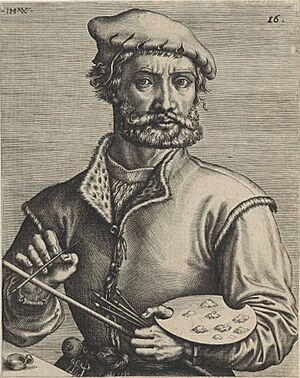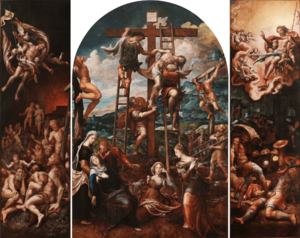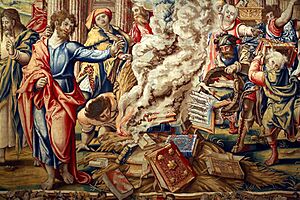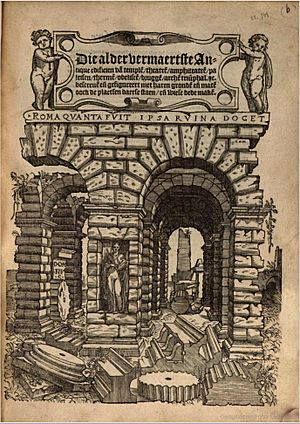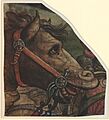Pieter Coecke van Aelst facts for kids
Pieter Coecke van Aelst (born August 14, 1502, in Aalst – died December 6, 1550, in Brussels) was a very talented artist from Flanders. He was a painter, sculptor, architect, writer, and designer. He created designs for woodcuts, gold items, stained glass, and tapestries. Most of his art focused on Christian religious stories. He worked in the cities of Antwerp and Brussels. He even became the official court painter for Charles V, Holy Roman Emperor.
Pieter Coecke van Aelst could speak many languages (he was a polyglot). He translated important books about architecture from ancient Roman and modern Italian into Dutch, French, and German. These translations were very important! They helped spread new ideas from the Renaissance across Northern Europe. They also helped change art and building styles from the old Gothic look to a newer, more "antique" (ancient Roman and Greek) style.
Contents
Life of Pieter Coecke van Aelst
Pieter Coecke van Aelst's father was the Deputy Mayor of Aalst. An early writer about Flemish artists, Karel van Mander, wrote in 1604 that Coecke van Aelst learned from Bernard van Orley. Van Orley was a leading Renaissance painter in Brussels. We don't have documents to prove this, but their art styles are very similar.
Karel van Mander also said that Pieter Coecke van Aelst later studied in Italy. In Rome, he supposedly drew ancient sculptures and buildings. There is no strong proof he traveled to Italy. However, his art shows Italian influences. He might have seen Raphael's tapestry designs in Brussels around 1516. But since Coecke van Aelst knew Raphael's fresco Triumph of Galatea in Rome, he likely did visit Italy.
Family and Travels
Pieter Coecke van Aelst married twice. His first wife was Anna van Dornicke in 1525, after he moved to Antwerp. Anna was the daughter of Jan Mertens van Dornicke, a successful painter in Antwerp. Jan Mertens might have been Coecke's teacher. Coecke van Aelst took over his father-in-law's workshop when he died in 1527. Pieter had two sons from this marriage, Michiel and Pieter II. Pieter II also became a painter.
In 1527, Coecke van Aelst joined the local Guild of Saint Luke in Antwerp. This was a group for artists. In 1533, he traveled to Constantinople (modern-day Istanbul, Turkey). He stayed there for a year. He tried to get the Turkish sultan to order tapestries from him, but this didn't work out.
During his trip, Coecke made many drawings. He drew buildings, people, and plants. This trip made him very interested in drawing nature accurately. This added a special touch to his tapestry designs. After he died, his wife published these drawings in a book. Its title was Ces moeurs et fachons de faire de Turcz avecq les regions y appertenantes ont este au vif contrefaictez (Antwerp, 1553). This means "These customs and ways of the Turks with the regions belonging to them have been truly depicted."
When he returned to Antwerp in 1534, Coecke van Aelst designed a huge figure. It was called 'Druon Antigoon' or the 'Giant of Antwerp'. Its head made of papier-mâché might still exist today. The giant first appeared in 1549 when Prince Philip (who later became King Philip II) visited Antwerp. The giant became a regular part of public parades in Antwerp for centuries.
In 1537, Coecke van Aelst was chosen as a leader (dean) of the Antwerp Guild of Saint Luke. He also received money from the Antwerp city government. Around this time, he got big jobs designing stained-glass windows, including for the Antwerp Cathedral.
Around 1538–1539, Coecke van Aelst married for the second time. His second wife, Mayken Verhulst, was from Mechelen and was a miniature painter. They had three children: two daughters named Katelijne and Maria, and a son named Pauwel. The famous painter Pieter Brueghel the Elder married Coecke van Aelst's daughter Maria (also called 'Mayken'). Karel van Mander said that Coecke van Aelst's second wife was the first teacher of her grandchildren, Pieter Brueghel the Younger and Jan Brueghel the Elder.
Coecke van Aelst was named court painter to Charles V just a few months before he died. He was in Brussels in 1550 when he passed away in December. His two youngest children also died at the same time. It's possible they all died from a contagious illness.
Many important painters learned from him. These include Gillis van Coninxloo, Willem Key, Hans Vredeman de Vries, Michiel Coxcie, and possibly Pieter Brueghel the Elder.
Artworks by Pieter Coecke van Aelst
General Style
Pieter Coecke van Aelst was a very versatile artist. He was a master designer who created projects in many different art forms. These included paintings on wood panels, sculptures, prints, tapestries, stained glass, and gold items. We don't have many paintings that are definitely signed by him.
His drawings are very important because they are the only works we know for sure he made himself. About forty drawings are considered his own work. Most of his drawings are designs for tapestries.
In his art, Coecke wanted to be as good as Italian artists of his time. From the late 1520s, his works started to show Italian influences. His figures became bigger and more impressive. His compositions showed more movement and drama. His main inspiration was Raphael and his group of artists. Coecke probably already knew their art in Antwerp. When he traveled to Turkey around 1533, he likely visited Mantua, Italy. Raphael's main student, Giulio Romano, worked there. Romano had a large collection of Raphael's drawings. Coecke must have studied these drawings closely during his visit. After returning to Flanders, Coecke's style changed a lot, becoming more like the Italian art he had seen.
Coecke had a large and well-organized workshop. He acted like a business owner. He gave his assistants his original ideas, and they helped turn them into finished artworks under his guidance. The art style he created was copied by many other artists.
Last Supper Paintings
Van Aelst's painting of the Last Supper became extremely popular in the 1500s. Many versions were made. The version from 1527, owned by the Duke and Duchess of Rutland in England, is thought to be the original. All other copies came from this one. The painting became even more famous through a print made by Hendrik Goltzius.
Van Aelst's Last Supper was inspired by Leonardo da Vinci's Last Supper (1498) and an engraving by Marcantonio Raimondi. This engraving was based on a lost drawing by Raphael. The hand gestures of the apostles came from Albrecht Dürer's print of the Last Supper from 1523.
There are about 45 versions of this painting. Many were made with the help of workshop assistants. A lot of these versions are dated, and 6 or 7 of them are from 1528. Van Aelst likely made the first drawing for the Last Supper. This drawing was then copied onto wood panels. You could order the painting in two sizes: 50 x 60 cm and 60 x 80 cm. The larger size was more popular.
Small Bible scenes in the background of the painting help explain its religious meaning. Through the window, you can see a scene of the Entry of Jesus Christ into Jerusalem. This was the main event before the Last Supper. Scenes of the Fall of Man and the Expulsion from Paradise are in the window's upper decorations. Medals on the wall show the Bible stories of the Slaying of Abel and David and Goliath. The scene of Abel's slaying is based on a print by Jan Gossaert. All these images emphasize the Christian idea of original sin and the belief that people's salvation depends on Christ's sacrifice.
St. Jerome in his Study Paintings
Coecke van Aelst and his workshop made many versions of St. Jerome in his Study.
Saint Jerome is honored by Christians for translating the Bible into Latin. He did this while living in a monastery in Palestine. A major influence on how St. Jerome was shown in Flemish art was Albrecht Dürer's St. Jerome in His Study from 1521.
In the version at the Walters Museum, Coecke van Aelst shows an Eastern setting. Through the window, you can see a landscape with camels. On the wall, there's a warning: "Cogita Mori" (Think upon death). This is a reminder of how short life is, and it's repeated by the skull. Other reminders of time passing and death coming soon are the image of the Last Judgment in the saint's Bible, the candle, and the hourglass.
Another version of this painting was sold at Christie's. This version also includes images that stress Christian beliefs. These beliefs are about how short human life is and how important Christ's sacrifice is for people to find salvation at the Last Judgment. This work is also very similar to Albrecht Dürer's St. Jerome in His Study from 1521.
Tapestry Designs
Pieter Coecke van Aelst was famous for his tapestry designs. These tapestries were made in workshops in Brussels. His designs were usually small, black-and-white drawings. For example, his design for the Martyrdom of St. Peter was in gray (grisaille) with touches of green and red. The names of other colors, like gold or blue, were written in.
Important people who ordered tapestries included Emperor Charles V, Francis I of France, Henry VIII of England, and Cosimo de' Medici. Coecke's fame as a tapestry designer grew because of his popular series. These included the Story of Saint Paul, the Seven Deadly Sins, the Story of Abraham, the Story of Vertumnus and Pomona, the Story of Joshua, the Story of the Creation, Poesia, the Conquest of Tunis, and Julius Caesar.
Between 1545 and 1550, Coecke designed tapestries where the scenes were set in buildings or landscapes. You can see this in the Conquest of Tunis, Poesia, and Story of the Creation tapestry series. Mary of Hungary, who governed the Netherlands, asked Coecke to help Jan Cornelisz Vermeyen. They worked together on the Conquest of Tunis tapestry series.
The Conquest of Tunis series was designed around 1546. It showed Charles V's successful recapture of Tunis from the Turks. The tapestries were designed about 11 years after the actual events. Coecke and Vermeyen worked together on the designs. Vermeyen had reportedly gone with Charles V on the military trip to Tunis. He had made sketches of the people, events, and landscapes he saw. The Conquest of Tunis tapestries were used a lot for propaganda by the Habsburg royal family. They were shown at all court parties, state events, and religious ceremonies. They had a special place in the main rooms of the Brussels palace and later in the Alcázar palace.
The Poesia series was inspired by stories from Ovid's Metamorphoses. Only one set of these tapestries was ever made after they were designed around 1547–1548. King Philip II of Spain bought the set in 1556. The Story of the Creation was designed around 1548. It was bought by Grand Duke Cosimo I de' Medici and his wife Eleanor of Toledo.
Graphic Works and Publications
Coecke van Aelst's studio was well known for its graphic works and publications. During his visit to Turkey, Coecke van Aelst drew local sights and scenes. His wife, Mayken Verhulst, published these drawings after his death in 1553. The book was titled Ces moeurs et fachons de faire de Turcz avecq les regions y appertenantes ont este au vif contrefaictez.
He also published and designed a book of prints called De seer wonderlijke...Triumphelijke Incompst van ... Prince Philips. This book celebrated the Joyous entry into Antwerp of Prince Philip (who later became King Philip II) in 1549. Coecke himself had designed some of the special arches and stages shown in the book. It is believed that the Spanish court liked these prints so much that it led to Coecke van Aelst being named court painter to Charles V.
Architectural Publications
Pieter Coecke van Aelst was a talented linguist. He is known for translating Vitruvius' De architectura into Flemish (Dutch). The book was called Die inventie der colommen met haren coronementen ende maten. Wt Vitruuio ende andere diuersche auctoren optcorste vergadert, voor scilders, beeltsniders, steenhouders, &c. En allen die ghenuechte hebben in edificien der antiquen. It was first published in 1539.
He, and later his widow Mayken Verhulst, published the five books of Sebastiano Serlio's architecture book Architettura. They translated it into Flemish, French, and High German. The first translation published was the fourth book of the Architettura in 1539. It was called Generale Reglen der architecturen op de vyve manieren van edificie.
Coecke van Aelst's translation of Vitruvius was praised by the scholar Dominicus Lampsonius. He said it was the only Dutch book to discuss building styles from other countries. Like Italian translations of Vitruvius from the 1500s, Coecke's translation used many woodcut pictures. It also used columns to show the difference between three ways of drawing buildings: plan, elevation, and view. This was a big change from earlier architecture books in the Low Countries, which usually didn't have many pictures.
Coecke van Aelst's 1539 Flemish translation of Serlio gave the Low Countries a relatively cheap translation of one of Europe's first illustrated architecture books. The original Italian version had come out in Venice only two years earlier. Coecke van Aelst's Flemish (Dutch) edition then became the basis for the first English translation of Serlio.
These translations of important Roman and Italian architecture books were crucial. They helped spread Renaissance ideas to the Low Countries. They also sped up the change from the late Gothic style to a modern "antique-oriented" architecture in Northern Europe. The translations also helped create a clear difference between planning a building and actually building it. This led to architecture becoming a new, separate field, different from the craft of a stonemason. In the Low Countries, the link between architecture and perspective also gained theoretical support from Coecke van Aelst's translations. Coecke's translations had a big impact on the architect and graphic artist Hans Vredeman de Vries. He is said to have copied their designs very carefully.
For "localization," Coecke van Aelst's translation made important changes to Serlio's original designs. For example, in one picture, he added 24 Latin block-letter patterns where Serlio had placed woodcuts of shields.
Images for kids
See also
 In Spanish: Pieter Coecke van Aelst para niños
In Spanish: Pieter Coecke van Aelst para niños


